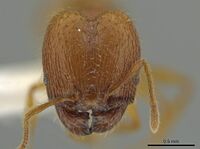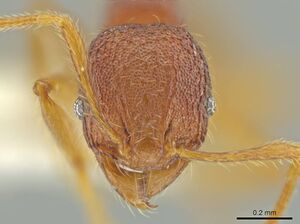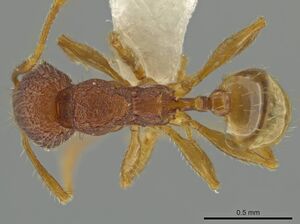Pheidole moskitia
| Pheidole moskitia | |
|---|---|

| |
| Scientific classification | |
| Kingdom: | Animalia |
| Phylum: | Arthropoda |
| Class: | Insecta |
| Order: | Hymenoptera |
| Family: | Formicidae |
| Subfamily: | Myrmicinae |
| Tribe: | Attini |
| Genus: | Pheidole |
| Species: | P. moskitia |
| Binomial name | |
| Pheidole moskitia Longino, 2019 | |
This species occurs in lowland wet forest. It is known from two sites in southeastern Honduras. It is moderately abundant in Winkler samples. One series recruited to a bait.
Identification
Minor: face and mesosoma uniformly foveolate, face and dorsal pronotum overlain with distinct reticulate rugulae; promesonotum box-like, promesonotal groove absent; propodeal spines about one third length of posterior face of propodeum; gaster smooth and shining; abundant erect setae on mesosomal dorsum and gaster; tibiae 1-3 erect setae; color red brown.
Major: inner hypostomal teeth stout, closely spaced; scape base terete; entire face feebly foveolate, overlain with irregular longitudinal rugulae, sculpture strongest anteriorly, fading posteriorly; propodeal spines one third length of posterior face of propodeum; gastral dorsum smooth and shining; sides of head with abundant erect setae; abundant flexuous erect setae on mesosomal dorsum and gaster; tibiae with 2-3 suberect setae.
Measurements, minor worker: HW 0.49, HL 0.54, SL 0.50, EL 0.09, WL 0.63, PSL 0.06, PTW 0.09, PPW 0.15, CI 90, SI 103, PSLI 12, PPI 176 (n=5).
Measurements, major worker: HW 0.99, HL 1.03, SL 0.55, EL 0.12, WL 0.81, PSL 0.07, PTW 0.16, PPW 0.35, CI 96, SI 56, PSLI 8, PPI 224 (n=5).
COI data on BOLD suggest this species is related to Pheidole beloceps. It shares the general habitus of P. beloceps, Pheidole belonorte, and Pheidole debilis but is somewhat larger (mean HW of minor worker 0.49 vs. 0.47 or less) and the major worker has a broader head (mean CI of major worker 96 vs. 85 or less). The minor worker of both P. moskitia and P. debilis have the side of the pronotum uniformly foveolate, while P. beloceps and P. belonorte have a medial smooth patch.
Distribution
Distribution based on Regional Taxon Lists
Neotropical Region: Honduras (type locality).
Distribution based on AntMaps
Distribution based on AntWeb specimens
Check data from AntWeb
Countries Occupied
| Number of countries occupied by this species based on AntWiki Regional Taxon Lists. In general, fewer countries occupied indicates a narrower range, while more countries indicates a more widespread species. |

|
Estimated Abundance
| Relative abundance based on number of AntMaps records per species (this species within the purple bar). Fewer records (to the left) indicates a less abundant/encountered species while more records (to the right) indicates more abundant/encountered species. |

|
Biology
Castes
Worker
Minor
Images from AntWeb
   
| |
| Paratype Minor. Specimen code CASENT0612083. Photographer J. Longino. | |
Nomenclature
The following information is derived from Barry Bolton's Online Catalogue of the Ants of the World.
- moskitia. Pheidole moskitia Longino, 2019: 46, fig. 21 (w.) HONDURAS.
Type Material
- HOLOTYPE: 1 major worker, Honduras, Gracias a Dios: Las Marias, 15.7092 -84.86232 ±120 m, 90 m, 9-Jun-2010, tropical rainforest, at bait (LLAMA, Ba-C-07-1-03-08) [MCZC, unique specimen identifier CASENT0612085].
- PARATYPES: major, minor workers: same data as holotype [CAS, MCZC]; same data except 15.71200 -84.86305 ±25 m, 100 m, ex sifted leaf litter (LLAMA, Wm-C-07-1-02) [CAS]; same data except 15.71011 -84.86304 ±20 m (Wm-C-07-1-03) [USNM]; same data except 15.72235 -84.88480 ±20 m, 620 m, 10-Jun-2010, tropical rainforest, ex sifted leaf litter (LLAMA, Wm-C-07-1-07) [DZUP]; same data except 15.72153 -84.88173 ±20 m, 560 m (Wm-C-07-1-09) [JTLC].
Description
Etymology
From the type locality (La Moskitia region of southeastern Honduras).
References
References based on Global Ant Biodiversity Informatics
- Longino J. T. 2019. Pheidole (Hymenoptera, Formicidae) of Middle American wet forest. Zootaxa 4599: 1-126

